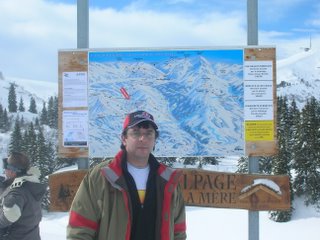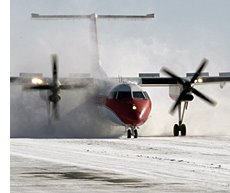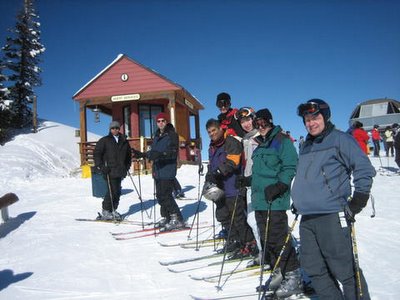
Eclipse at Sun Valley
Absent Staff, Dull DécorAmong Old Hotel's Ills;The Escape to Knob Hill
By LAURA LANDRO Staff Reporter of THE WALL STREET JOURNALFebruary 3,
2006; Page W3
When Union Pacific Railroad baron Averell Harriman created Sun Valley in 1936, it was
the first destination ski resort in America, an outpost of luxury, glamour and impeccable service. Ernest Hemingway finished "For Whom the Bell Tolls" in one of its rooms; "Gone With the Wind" producer David O. Selznick personally helped promote it as a haunt for stars like Clark Gable, Gary Cooper and Claudette Colbert.
Gone with the wind these days, though, are the former heights of luxury and service.
Oil-and-truck-stop magnate Earl Holding, owner of the Little America chain of hotels in the West, bought Sun Valley Co. in 1977, and has poured millions into state-of-the-art snowmaking equipment, showcase ski lodges and modern conference facilities in recent years. But he seems to have paid less attention to the quality of the resort's historic hotel and its staff.
PEAK RATES
Here are some
packages across the country for standard rooms at ski resorts on a grand scale similar to Sun Valley.
With bland, institutional décor, little atmosphere and few amenities, the hotel appears to have more in common with the naval-convalescence hospital it served as during World War II than the famed destination of its heyday. Its once-original ersatz Tyrolean village theme is tired, and what passes for service is provided by young foreign staffers with an often-shaky command of the English language, who, while polite, seem to have little training or professional supervision.
My husband and I were eager to revisit Sun Valley for its spectacular location in the Idaho Rockies near Bald Mountain; neither of us had been there in 20 years. Though it remains hard to reach, with few direct flights into the local airport in Hailey, and many commercial flights connecting into Twin Falls 90 minutes away, Sun Valley and the neighboring town of Ketchum have become a hub of luxury condominiums, palatial second homes and high-end boutiques and restaurants.
Chain-Hotel Effect
The annual Allen & Co. media conference in July brings moguls like Bill Gates and Rupert Murdoch to the resort, stacking up private planes the length of the Hailey airstrip. And the area's hiking, rafting and fishing draw visitors year-round.
While Sun Valley Co. rents out private homes and condos (where many of the high-profile Allen & Co. conference attendees stay), we wanted to experience one of the 257 rooms in the main Sun Valley Lodge and adjacent Inn, opened in 1937. I called to ask for the best room available, and was offered a $439-a-night "parlor suite" in the inn, which was once the resort's economy option but was overhauled two years ago with new conference facilities and refurbished rooms and public spaces. But the overall effect is strictly chain-hotel, with no special touches.
True, I may care more about amenities than die-hards who just want a comfy place to sleep après ski. But, when compared with some top-notch Western ski-resort rivals, Sun Valley's status goes downhill faster than a slacker on a new snowboard. The St. Regis in Aspen, Colo., ferries guests around in Lexus vehicles, and its new spa, with warm and cold waterfalls, offers Champagne, truffles and cashmere throws along with treatments. At the two-year-old Four Seasons resort in Jackson Hole, Wyo., there's a 24-hour concierge and warm peppermint-scented face cloths and s'mores at the pool.
By contrast, after the long trip from New York to Sun Valley, we arrived at the main lodge in midafternoon, surprised to find nary a bellman or doorman in sight. I went inside to the front desk, where a young woman checked me in perfunctorily, handed me a key and waved me in the general direction of the inn.
Back in the car, we found our way to the unattended inn entrance. The only people in the lobby were a group of wet but cheerful senior citizens in bathing suits and shorts, on their way back from the pool -- members of the Ancient Skiers club, in town for their annual visit. The front desk was empty, but after a few minutes a receptionist came out and summoned a bellman, who took our bags.
As we walked down the hall we were struck by a stale, unpleasant smell. Our dark first-floor suite, which looked out onto the sidewalk that led to the mall connecting inn and lodge, was crammed with stained upholstered furniture, a dingy quilted bedspread and a bathroom so small you had to lean into the tub to close the door. As we soon found, the tub -- with a flimsy, unclean-looking cloth curtain -- was so shallow it was impossible not to flood the floor when showering. The only saving grace was a second sink in a granite vanity near the closets. Though there were two new plasma TVs in the bedroom and sitting area, nothing was in the minibar, not even bottled water. No one answered the phone at housekeeping when we called to schedule turndown service.
I went back to the desk to ask if there was a brighter room, perhaps with a view, but was told nothing was available; though the place seemed kind of dead, the inn and lodge were apparently full with a couple of groups, including the ancient skiers. (A founder, Irv Pratt, says ages of the Northwest group range from 60 to 90.)
We wandered around the lodge and inn looking at the brightly colored 1930s-era ski posters and examining historical photos of movie stars and celebrities enjoying Sun Valley. The original round glass-enclosed outdoor pool has seen better days, and the inn's small fitness room had old equipment and torn carpeting.
Big Portrait, Little Service
Though the inn's Ram Restaurant once was popular with actresses like Norma Shearer, we found it unappealing, with an unimpressive buffet for breakfast, so we walked to one of the mall restaurants, Konditorei. The service was painfully slow, but we enjoyed a well-cooked omelet and decent oatmeal.
For lunch, we tried Gretchen's, the main lodge's restaurant. Formal and stuffy, it's dominated by a massive portrait of Mr. Holding's wife, Carol, in a saintly pose. We contemplated it for 20 minutes, because no one ever came to wait on us, even though only two or three other tables were occupied. Finally we just got up and went back to the Konditorei, where the grilled sandwiches and fries came out ice-cold. We had to wave down one of the four staffers lounging behind the counter to send it back.
To its credit, the resort's day lodges and lifts -- River Run ski lodge, built in 1996, and the newer Carol's Dollar Mountain Ski Lodge -- have great facilities for kids and are lively and attractive. There's skating, tennis, cross-country skiing and nightly entertainment.
With 202 inches of natural snowfall on "Baldy" this season, the resort says, Sun Valley is boasting some of the best skiing in 20 years and is rarely overcrowded. Renting a resort condo may be the best option for families; a two-bedroom starts at $239 nightly.
Sun Valley General Manager Wallace Huffman said it was unfortunate that we had a bad experience, but says most guests are extremely pleased with the rooms and service, and many return year after year. Because of a limited pool of local employees, he says, foreign staffers on temporary visas make up about 350 of the resort's 1,500 workers; though new ones are trained on the job, about half return each season.
As for the rooms and décor, "we haven't spared a dime" on remodeling, he says, but the limitations of the old buildings restrict major reconstruction. Still, Mr. Huffman says, the resort recognizes the need to offer a higher level of luxury and amenities, and expects to start construction in 15 months on a new 150-room high-end hotel with a full-service spa on the site of one of its parking lots.
After dinner our first night, we hatched an escape plan. We'd heard good things about the family-run 26-room Knob Hill Inn in Ketchum, part of the upscale Relais & Châteaux Group, and when we stopped by, a suite was available for the same price we were paying at the inn. We told the Sun Valley resort that we'd be leaving; we were charged half the room rate for the second night we'd booked, a penalty that seemed worth it. We were soon ensconced in a nice third-floor suite with a spacious marble bathroom at the Knob Hill, overlooking a snow-covered hill dotted with evergreens.
With just 26 rooms and suites, the inn has a delightful breakfast room, where we enjoyed delicious cornmeal pancakes, lattes, freshly squeezed orange juice and a buffet. It has a small pool and gym, but we paid a daily rate to use the nearby Zenergy health club, which has first-class fitness facilities, two pools and massage therapists. Lunch was perfect at Cristina's in town, and we sampled Ketchum restaurants, including Michel's Christiania, Il Naso and Felix's.
As for the Sun Valley resort, the only thing we missed were the members of the Ancient Skiers club. They really livened up the place.










